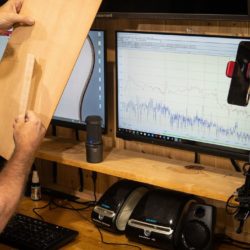
Voicing Science and the Future of Lutherie
When I first took my stab at lutherie, I mostly did maintenance work. Fret work, bone nuts and saddles, and basic setups made up the bulk of my daily agenda. I was exposed to many great guitars, both acoustic and electric. And even though I played electrics out on the gig, my primary interest was always acoustic guitars. I was just obsessed with figuring out what made them tick. Once I moved into instrument making, I found it difficult to produce the concert-level quality instruments I had become so accustomed to in my repair days. I was inspired to take a more analytic approach to instrument making, which was ultimately an attempt to tighten-up the consistency, tone, and overall playing experience for my customers.The science of instrument making is an extraordinarily interesting world. My studies began with basic data collecting, such as material strength and weights, until I eventually developed a spreadsheet to better track my builds and improve the sound quality of my guitars. Eventually, this approach introduced me to a whole culture of scientists and engineers that were pursuing the same passion, and they were very open to the exchange of information. This solidified my commitment to the field of voicing science, and vastly improved the quality of my instruments.What we are experiencing today is an explosion in the study of sound. This is a revolution that has been decades in the making.Over time, these methods have picked up steam, with most of today’s hand-builders adopting some level of voicing science to improve the outcome of their instruments. In the end, all of this is an attempt to unlock the methods of the finest luthiers, such as the violin makers building in the European tradition, makers such as Lloyd Loar, or even the Martin Guitar Company’s contributions from the mid-to-late 1930s.But what we are experiencing today is an explosion in the study of sound. This is a revolution that has been decades in the making. My first exposure was in the ’90s when I met a classical guitar maker by the name of Richard Schneider, who worked alongside a physical chemist named Michael Kasha, who was not a luthier himself. Together, they teamed up and made many advancements in the science of sound. Another major push was the book Left-Brain Lutherie written by David C. Hurd, Ph.D. This is a great think-book that put most modern luthiers on the path of analytical guitar making. In our shop, this book was on the bench constantly, as it helped us maneuver through many tough questions about instrument acoustics. Most recently, Australian luthier Trevor Gore published Contemporary Acoustic Guitar Design and Build, which has been a go-to for most modern luthiers. Trevor is a talented builder, and his contributions will inspire many others to come.But what does this mean to you, the player? This is the question. In the early ’90s, us builders noticed a major improvement in the quality of builds in the micro-building market. This was mostly due to groups such as the Guild of American Luthiers and the Healdsburg Guitar Festival. These groups offered a platform for guitar makers to compare notes, and this information exchange vastly improved the qualities of their builds. About five years after that, we all noticed everyone’s building style and finish went through a major transformation. This illustrates why the dawn of voicing science is so important—the exchange of science and information improves instrument quality for everyone. This is what is happening now. All the serious makers are currently implementing techniques set into motion by the research of the past 40 years and are sharing their findings with the world.These days, I am noticing a major improvement in the tone and the stability of acoustic instruments. One builder who stands out in my mind is Colorado luthier Michael Bashkin, whose OM classical guitar is a major play for tonal excellence. So, for you the guitar buyer, this is a very good time to be shopping around the custom-guitar market. There is no doubt we are experiencing the next level in guitar making. And it will only get better.
Read more »
Pedalpocalypse: Kirk Fletcher on the 3 pedals he couldn’t live without. Full video @ guitarworld.com

JUDAS PRIEST's RICHIE FAULKNER Says He Underwent Second Open-Heart Surgery In August
JUDAS PRIEST guitarist Richie Faulkner has revealed that he underwent a second heart surgery in early August. The latest operation took place nearly a year after the 42-year-old British-born musician suffered an acute cardiac aortic dissection during a performance at the Louder Than Life festival, j…
Read more »
FALLING IN REVERSE Cancels Festival Appearance Over 'Missing Laptops': 'It's Like Driving A Car Without An Engine'
FALLING IN REVERSE has been criticized by fans for pulling out of this year’s WIIL Rock festival over “missing” laptops.
Just hours before the Ronnie Radke-fronted outfit was supposed to appear at the one-day event on Saturday, September 24 at Lake County Fairgrounds in Grayslake, Illinois, the sing…

PAPA ROACH's Goal Is To 'Carry The Torch For Rock And Roll', Says JACOBY SHADDIX
PAPA ROACH singer Jacoby Shaddix and guitarist Jerry Horton were interviewed by Liv Maddix of 105.7 The Point backstage at Pointfest on Saturday, September 24 at Hollywood Casino Amphitheatre in St, Louis, Missouri. Speaking about how they embrace collaborations with other artists, Jacoby said: “We…
Read more »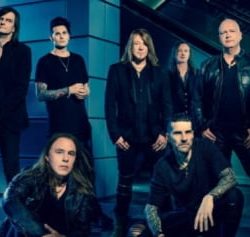
HELLOWEEN Announces Spring 2023 North American Tour With HAMMERFALL
German power metallers HELLOWEEN will embark on the “United Forces” tour of North America in May 2023. Support on the 13-date trek will come from Swedish metallers HAMMERFALL. Tickets will go on sale on Friday, September 30 at 10 a.m. local time.
HELLOWEEN singer Andi Deris comments: “We can’t wait…
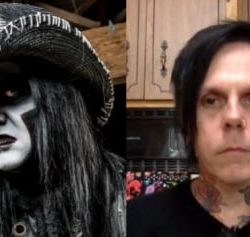
WEDNESDAY 13 Blasts ACEY SLADE In MURDERDOLLS Dispute: He Is An 'Ex-Touring Member' Who 'Didn't Play A Single Note' On The Album
Founding MURDERDOLLS vocalist Wednesday 13 has once again accused the band’s former guitarist Acey Slade of taking the MURDERDOLLS name behind late SLIPKNOT drummer Joey Jordison’s back.
Last month, it was announced that Slade and former MURDERDOLLS bassist Eric Griffin would take part in a signing…
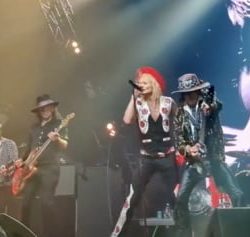
MICHAEL MONROE Says HANOI ROCKS Reunion At His 60th-Birthday Concert Was 'Amazing'
Michael Monroe, who turned 60 in June, celebrated the milestone with a bang on September 23 at the Helinki Ice Hall (Helsingin Jäähalli) in Finland. As the grand finale of the concert, the original lineup of HANOI ROCKS, one of Finland’s most significant rock bands of all time, took the stage: Monro…
Read more »
Tony Iommi and Epiphone Reveal the Tony Iommi SG Special
Black Sabbath guitarist Tony Iommi and Epiphone partner on a new version of his beloved SG.The Epiphone Tony Iommi SG Special features a two-piece mahogany body, a bound one-piece mahogany neck with a rounded profile, an Indian laurel fretboard with 22 frets, a Graph Tech nut, Grover Rotomatic tuners with contemporary style buttons and chrome-covered Epiphone PRO P-90 pickups that are wired to CTS potentiometers and Orange Drop capacitors. A static cling reproduction of Tony’s “Monkey” sticker is in the included hardshell case. The new Epiphone Tony Iommi SG Special is available in both left and right-handed versions.Tony Iommi’s riffs, heavy tones, and influential albums helped creat the blueprint for heavy metal and many other genres to follow. After an early accident that almost ended his career as a guitarist, Tony persevered to become universally loved and revered. And while Tony’s innovative tuning and playing styles have always been a major part of his monstrous tones, his original, heavily–modified 1964 Gibson SG Special, nick-named “Monkey” was at the center of it all.Tony Iommi is synonymous with heavy rock, his innovative, de-tuned, dark riffs are considered to be the blueprint for hundreds of bands that followed. Born on February 19, 1948, in Birmingham, England, left-handed Tony picked up the guitar after being inspired by the likes of Hank Marvin & the Shadows as a teenager. Iommi’s musical career was nearly derailed prematurely as he suffered a horrible accident at a sheet metal factory, when a machine sliced off the tips of the fingers on his right hand. Figuring that his guitar playing days were behind him, a friend turned him onto guitarist Django Reinhardt (who lost use of two fingers in a gypsy caravan campfire accident), inspiring Tony to give the six-string another go, with soft plastic tips attached to the ends of his fingers. By 1967, he had played with several blues-based rock bands one of which evolved into Polka Tulk (later titled Earth and then Black Sabbath), with bassist Terry “Geezer” Butler, drummer Bill Ward , and singer John “Ozzy” Osbourne.Epiphone Tony Iommi SG SpecialMore info at epiphone.com.
Read more »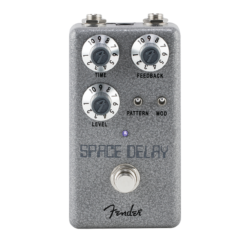
Fender Hammertone Space Delay Review
An extremely affordable digital take on analog echoes. Fender’s Space Delay, from the company’s recent Hammertone series, is a digital delay with a tape-echo’s soul. Back in June we reviewed the more conventional Hammertone Delay, which we noted was “ a lot more fun than most inexpensive digital delays.” That holds true for the company’s more analog-style—and equally affordable—Space Delay. Echo Family ResemblanceTape echo-inspired delays typically utilize rhythmic patterns and modulation to approximate the multi-head capabilities and tape warble in real tape delays. But there’s a secondary benefit to this kind of functionality: It’s fun! And I often found myself situating the Space Delay within arm’s reach rather than at my feet so that I could use each function to the fullest. The Space Delay is configured a lot like the Hammertone Delay, except the Space Delay swaps the type switch for a pattern control which moves between quarter-note delay, pattern 1, and pattern 2, which are pre-programed rhythmic patterns. To some extent, the two patterns offer the ping-pong echo interplay that you hear in vintage multi-head echo units like the Roland Space Echo and the Binson Echorec. And playing to the gallop-style feel of each pattern is inspiring. Each pattern is made up of quarter and eighth notes, Pattern 1 situates the quarter-note first in the pattern, while pattern 2 situates the faster repeat first in the sequence. The pronounced attack on each initial delay is crisp and accurate, which helps drive the rhythmic push for each pattern and the phrases you create with them.The other switch turns on the modulation and there are two small controls on the inside of the pedal to adjust modulation speed and depth. The factory setting is a nice, flowing setting that stops well short of seasick vibes. Still, it was a bit heavy on the depth, so I turned that down a bit to allow the modulation to sit more comfortably in the background. Extreme modulation depth settings are fun too if you’re in the mood to get noisy. Some of the chorus-like tones at these settings might be a bit metallic sounding in the high end for some, but they still mesh nicely with cleaner low-repeat, high-feedback settings.Dirty DeedsFor many, the primary appeal of tape- and analog-style delay is how repeats degrade and lose fidelity as they repeat. The Space Delay nails that haze. There’s enough natural grit on the repeats to pass as an all-analog creation in many cases, and you can hear a lot of analog-style warmth in the audio clips that accompany the digital version of this article. As nice as those dark repeats can sound, I still wish there was a tone control to brighten those repeats up at times. Amid the swirling sound of a loud gig, darker repeats can go missing, and I tend to prefer digital delays in those settings for that reason. So, it’s worth trying the Space Delay before you buy to see how the darker repeats fit with the other elements of your signal chain.There’s enough natural grit on the repeats to pass as an all-analog creation in many casesThe feedback is satisfying in very analog-like ways too. It’s especially cool to be able to use heavy feedback settings—right at the edge of oscillation—and then walk the line between a long wash of repeats and self-oscillation, simply by adjusting your picking dynamics. It’s not easy to coax that sensitivity out of more pristine digital units.The VerdictThe Space Delay is a great gateway to the world of tape-echo ambience at a exceptional price. I do wish there was a bit more flexibility in the repeat patterns, a way to brighten repeats up, or maybe even tap tempo. But for $99 the Space Delay is a killer way to work a little warble, tape-style fog, and rhythmic drive into your delay textures.Hammertone Space Delay Pedal
Classic analog tape delay warble in a budget-friendly package!Pattern and Modulation switching provide stellar creative foundationsTime, Feedback, and Level controls allow for maximum delay customizationAnalog Dry-Through technology expertly preserves your guitar tone while in useTrue-bypass switching for easy integration into your pedal chain
Read more »